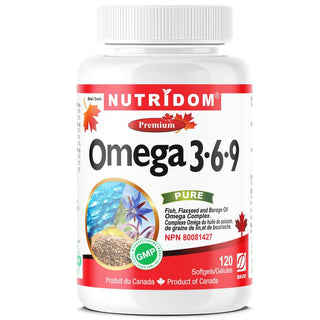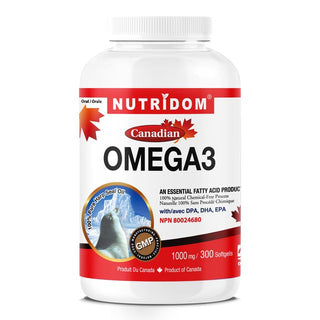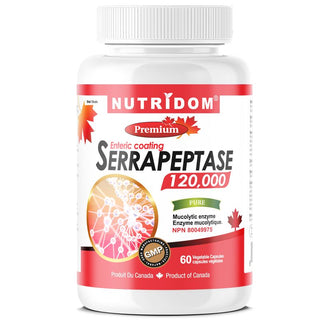- GMO Free
- Third-Party Tested
- Contains No Gluten, Dairy, Soy, Eggs and Corn
Medicinal Ingredients (per capsule):
120,000 Serrapeptidase Unit...60 mg
Non-Medicinal Ingredients:
Brown rice flour, Hypromellose (vegetable capsule shell), Ethyl cellulose(Enteric coating)
Duration of Use:
Consult a health care practitioner for use beyond 7 days
Recommended Dose:
Adults: 1 Tablet 1 times per day.
Take 2 hours after a meal
Cautions and Warnings:
If symptoms persist or worsen, discontinue use and consult a health care practitioner. If you are pregnant or breastfeeding, consult a health care practitioner prior to use. If you have a gastrointestinal lesion/ulcer, are taking anticoagulant/blood thinner or anti-inflammatory medication, or are having surgery, consult a health care practitioner prior to use.
Known Adverse Reactions:
Hypersensitivity/allergy has been known to occur; in which case, discontinue use.
Q: What is Nutridom Serrapeptase 120,000 SU?
A: Nutridom Serrapeptase 120,000 SU is a high-quality supplement designed to support overall health and wellness. Each capsule is enteric-coated and contains 120,000 Serratiopeptidase Units (SU) of serrapeptase. The product is Non-GMO and free from gluten, soy, and dairy.
Q: What are the main benefits of taking Nutridom Serrapeptase 120,000 SU?
A: The main benefits include anti-inflammatory properties, pain relief, support for respiratory health, promotion of wound healing, cardiovascular health support, scar tissue reduction, relief from inflammatory bowel disease symptoms, immune function support, reduction of swelling and edema, and potential improvement of Lyme disease symptoms.
Q: How does Nutridom Serrapeptase reduce inflammation?
A: Serrapeptase reduces inflammation by breaking down inflammatory compounds and proteins, helping to decrease swelling and promote tissue repair.
Q: Can Nutridom Serrapeptase help with pain relief?
A: Yes, serrapeptase has analgesic properties that may help alleviate pain associated with chronic conditions such as arthritis, fibromyalgia, and joint pain by reducing inflammation and promoting tissue repair.
Q: Is Nutridom Serrapeptase beneficial for respiratory health?
A: Yes, serrapeptase has mucolytic properties that help break down and dissolve mucus and phlegm in the respiratory tract, improving breathing and reducing congestion in conditions like chronic bronchitis, asthma, and sinusitis.
Q: How does Nutridom Serrapeptase promote wound healing?
A: Serrapeptase enhances wound healing by reducing inflammation, promoting tissue regeneration, and improving circulation to the affected area.
Q: Can Nutridom Serrapeptase support cardiovascular health?
A: Yes, serrapeptase helps improve cardiovascular health by breaking down fibrin, reducing fibrin buildup in the arteries and veins, improving blood flow, and lowering the risk of blood clots and cardiovascular events.
Q: How does Nutridom Serrapeptase reduce scar tissue?
A: Serrapeptase reduces scar tissue formation by breaking down excess fibrin and promoting the remodeling of damaged tissue, which may help reduce scar formation after surgery or injury.
Q: Is Nutridom Serrapeptase helpful for inflammatory bowel disease (IBD)?
A: Some studies suggest that serrapeptase may help reduce inflammation and improve symptoms in people with inflammatory bowel diseases such as Crohn's disease and ulcerative colitis.
Q: Can Nutridom Serrapeptase support immune function?
A: Yes, serrapeptase helps modulate the immune system and support immune function by reducing inflammation and promoting tissue repair, enhancing the body's defense against infections and diseases.
Q: How does Nutridom Serrapeptase reduce swelling and edema?
A: Serrapeptase effectively reduces swelling and edema by breaking down excess fluid and inflammatory compounds in the body, making it beneficial for conditions such as post-operative swelling, sports injuries, and lymphedema.
Q: Is Nutridom Serrapeptase beneficial for Lyme disease symptoms?
A: Some anecdotal evidence suggests that serrapeptase may help alleviate symptoms of Lyme disease, including joint pain, inflammation, and fatigue, although more research is needed in this area.
Q: How should I take Nutridom Serrapeptase 120,000 SU?
A: Follow the dosage instructions on the product label or consult with a healthcare provider for personalized advice. It is typically recommended to take one capsule daily on an empty stomach.
Q: Is Nutridom Serrapeptase suitable for long-term use?
A: Yes, Nutridom Serrapeptase is safe for long-term use when taken as directed, providing continuous support for inflammation reduction, pain relief, and overall health.
Q: Can Nutridom Serrapeptase be taken with other supplements or medications?
A: Consult with a healthcare provider before taking Nutridom Serrapeptase, especially if you are on other supplements or medications, to ensure there are no potential interactions.
Nutridom Serrapeptase 120,000 SPU (60 Veggie Capsules)
- Unit price
- /per
Your order ships carbon neutral
Adding product to your cart
- GMO Free
- Third-Party Tested
- Contains No Gluten, Dairy, Soy, Eggs and Corn
Medicinal Ingredients (per capsule):
120,000 Serrapeptidase Unit...60 mg
Non-Medicinal Ingredients:
Brown rice flour, Hypromellose (vegetable capsule shell), Ethyl cellulose(Enteric coating)
Duration of Use:
Consult a health care practitioner for use beyond 7 days
Recommended Dose:
Adults: 1 Tablet 1 times per day.
Take 2 hours after a meal
Cautions and Warnings:
If symptoms persist or worsen, discontinue use and consult a health care practitioner. If you are pregnant or breastfeeding, consult a health care practitioner prior to use. If you have a gastrointestinal lesion/ulcer, are taking anticoagulant/blood thinner or anti-inflammatory medication, or are having surgery, consult a health care practitioner prior to use.
Known Adverse Reactions:
Hypersensitivity/allergy has been known to occur; in which case, discontinue use.
Q: What is Nutridom Serrapeptase 120,000 SU?
A: Nutridom Serrapeptase 120,000 SU is a high-quality supplement designed to support overall health and wellness. Each capsule is enteric-coated and contains 120,000 Serratiopeptidase Units (SU) of serrapeptase. The product is Non-GMO and free from gluten, soy, and dairy.
Q: What are the main benefits of taking Nutridom Serrapeptase 120,000 SU?
A: The main benefits include anti-inflammatory properties, pain relief, support for respiratory health, promotion of wound healing, cardiovascular health support, scar tissue reduction, relief from inflammatory bowel disease symptoms, immune function support, reduction of swelling and edema, and potential improvement of Lyme disease symptoms.
Q: How does Nutridom Serrapeptase reduce inflammation?
A: Serrapeptase reduces inflammation by breaking down inflammatory compounds and proteins, helping to decrease swelling and promote tissue repair.
Q: Can Nutridom Serrapeptase help with pain relief?
A: Yes, serrapeptase has analgesic properties that may help alleviate pain associated with chronic conditions such as arthritis, fibromyalgia, and joint pain by reducing inflammation and promoting tissue repair.
Q: Is Nutridom Serrapeptase beneficial for respiratory health?
A: Yes, serrapeptase has mucolytic properties that help break down and dissolve mucus and phlegm in the respiratory tract, improving breathing and reducing congestion in conditions like chronic bronchitis, asthma, and sinusitis.
Q: How does Nutridom Serrapeptase promote wound healing?
A: Serrapeptase enhances wound healing by reducing inflammation, promoting tissue regeneration, and improving circulation to the affected area.
Q: Can Nutridom Serrapeptase support cardiovascular health?
A: Yes, serrapeptase helps improve cardiovascular health by breaking down fibrin, reducing fibrin buildup in the arteries and veins, improving blood flow, and lowering the risk of blood clots and cardiovascular events.
Q: How does Nutridom Serrapeptase reduce scar tissue?
A: Serrapeptase reduces scar tissue formation by breaking down excess fibrin and promoting the remodeling of damaged tissue, which may help reduce scar formation after surgery or injury.
Q: Is Nutridom Serrapeptase helpful for inflammatory bowel disease (IBD)?
A: Some studies suggest that serrapeptase may help reduce inflammation and improve symptoms in people with inflammatory bowel diseases such as Crohn's disease and ulcerative colitis.
Q: Can Nutridom Serrapeptase support immune function?
A: Yes, serrapeptase helps modulate the immune system and support immune function by reducing inflammation and promoting tissue repair, enhancing the body's defense against infections and diseases.
Q: How does Nutridom Serrapeptase reduce swelling and edema?
A: Serrapeptase effectively reduces swelling and edema by breaking down excess fluid and inflammatory compounds in the body, making it beneficial for conditions such as post-operative swelling, sports injuries, and lymphedema.
Q: Is Nutridom Serrapeptase beneficial for Lyme disease symptoms?
A: Some anecdotal evidence suggests that serrapeptase may help alleviate symptoms of Lyme disease, including joint pain, inflammation, and fatigue, although more research is needed in this area.
Q: How should I take Nutridom Serrapeptase 120,000 SU?
A: Follow the dosage instructions on the product label or consult with a healthcare provider for personalized advice. It is typically recommended to take one capsule daily on an empty stomach.
Q: Is Nutridom Serrapeptase suitable for long-term use?
A: Yes, Nutridom Serrapeptase is safe for long-term use when taken as directed, providing continuous support for inflammation reduction, pain relief, and overall health.
Q: Can Nutridom Serrapeptase be taken with other supplements or medications?
A: Consult with a healthcare provider before taking Nutridom Serrapeptase, especially if you are on other supplements or medications, to ensure there are no potential interactions.
Blog posts

- gut health
- HEAT HEALTH
- IMMUNE HEALTH
- Longevity
- Mental clarity
Do You Need Supplements? Here’s What You Should Know
In today’s fast-paced world, maintaining a nutritionally balanced diet can be challenging. Even with the best intentions, many people struggle to get all the essential vitamins, minerals, and nutrients their...
Good price good quality and good customer service.






































